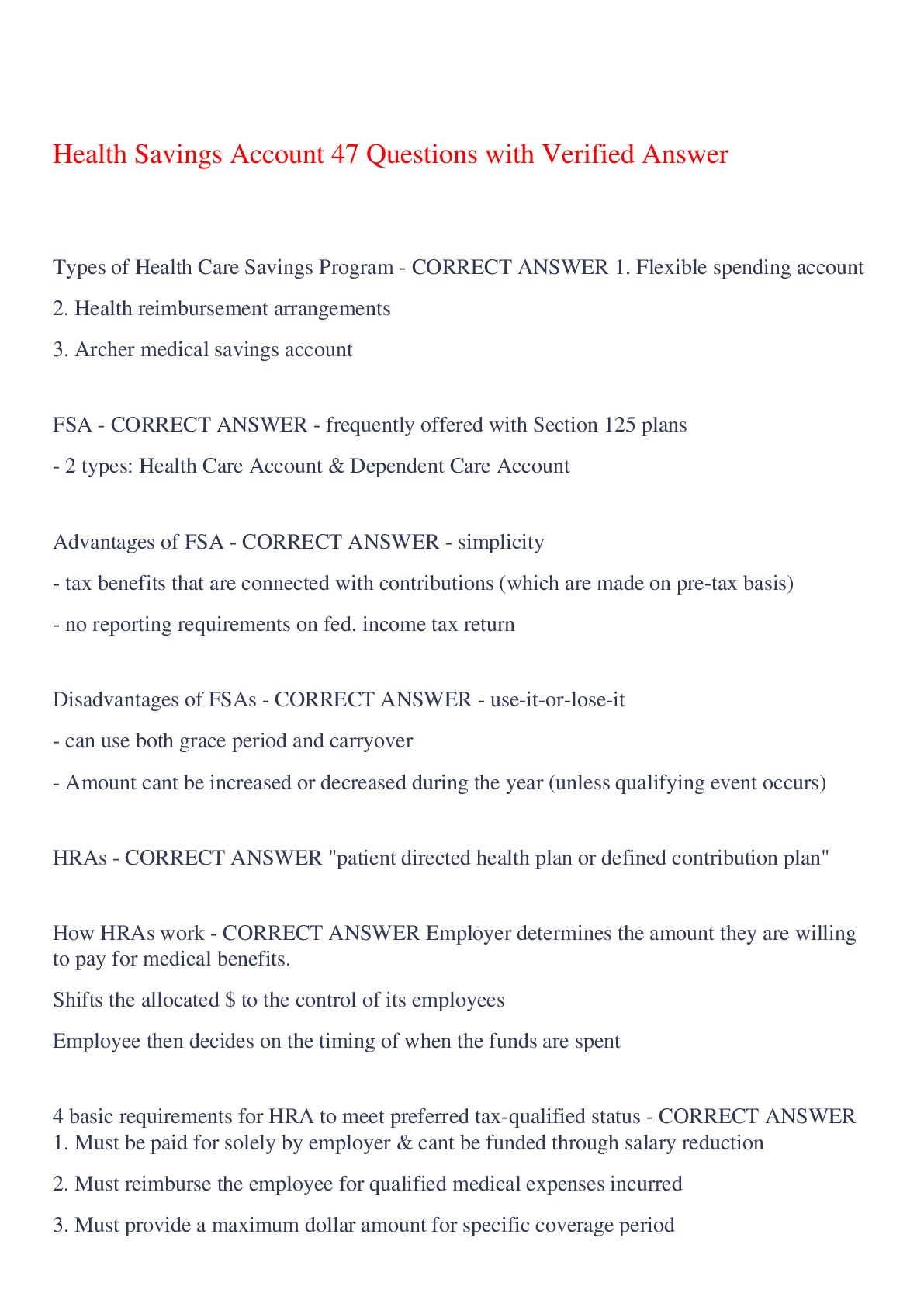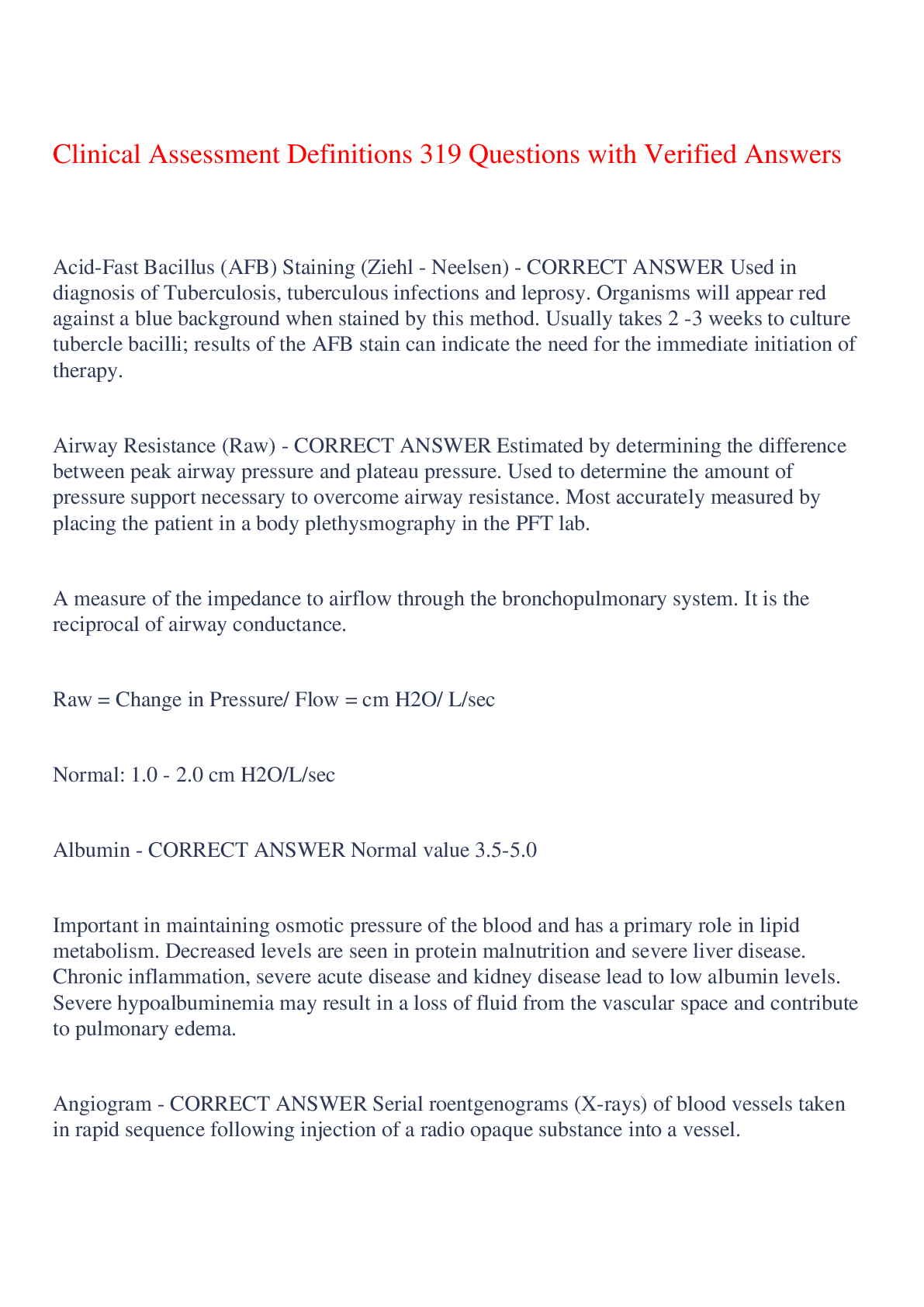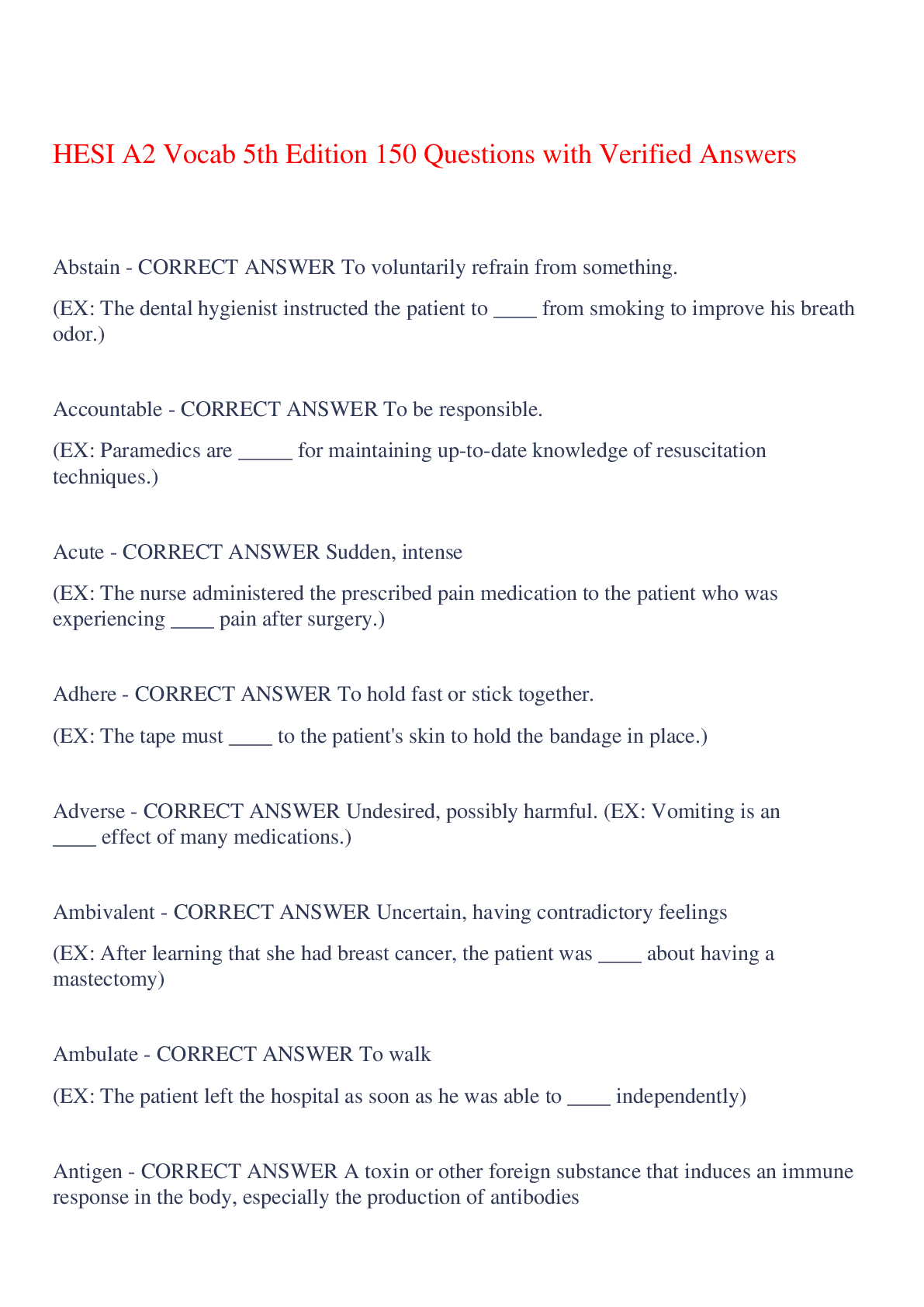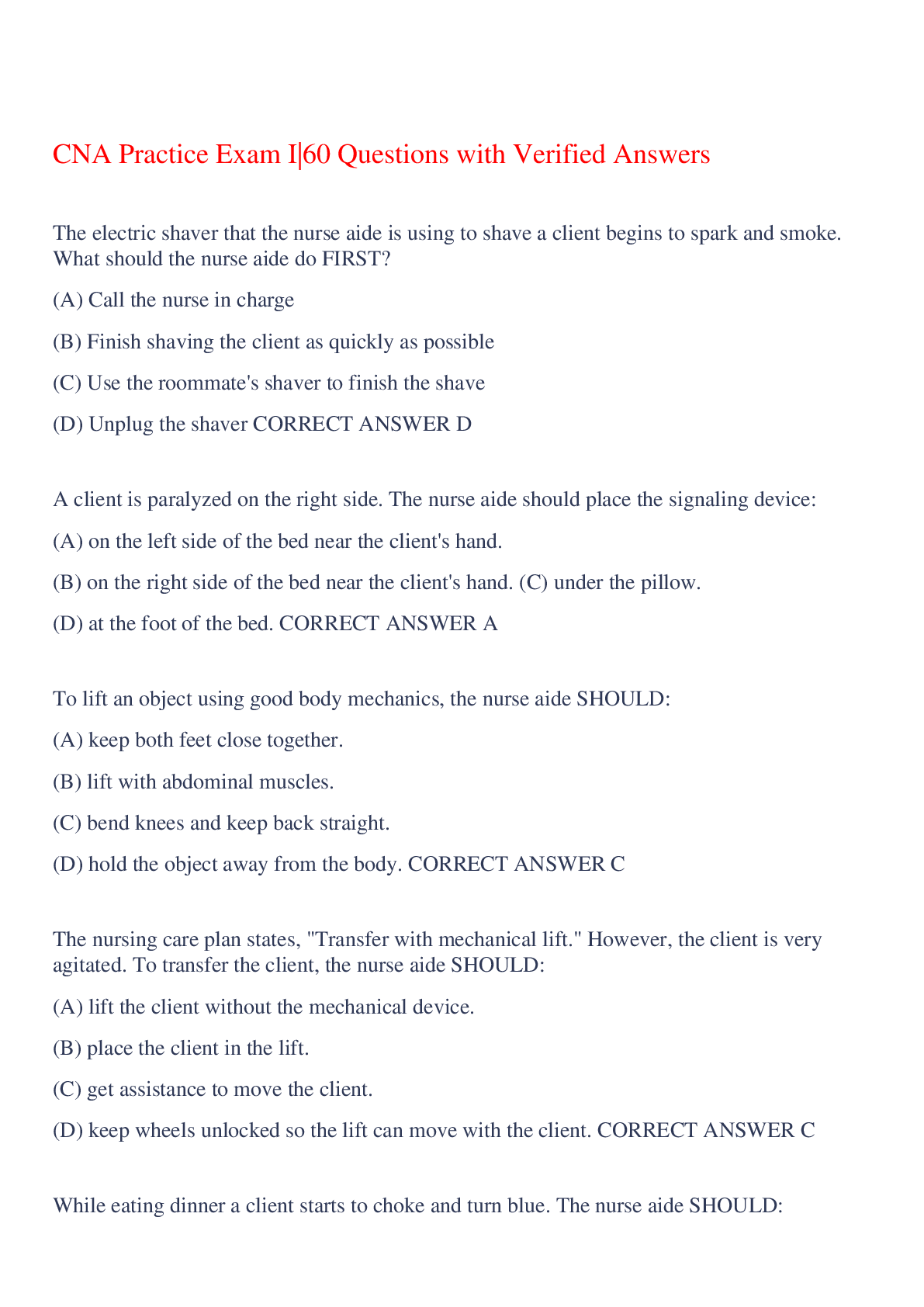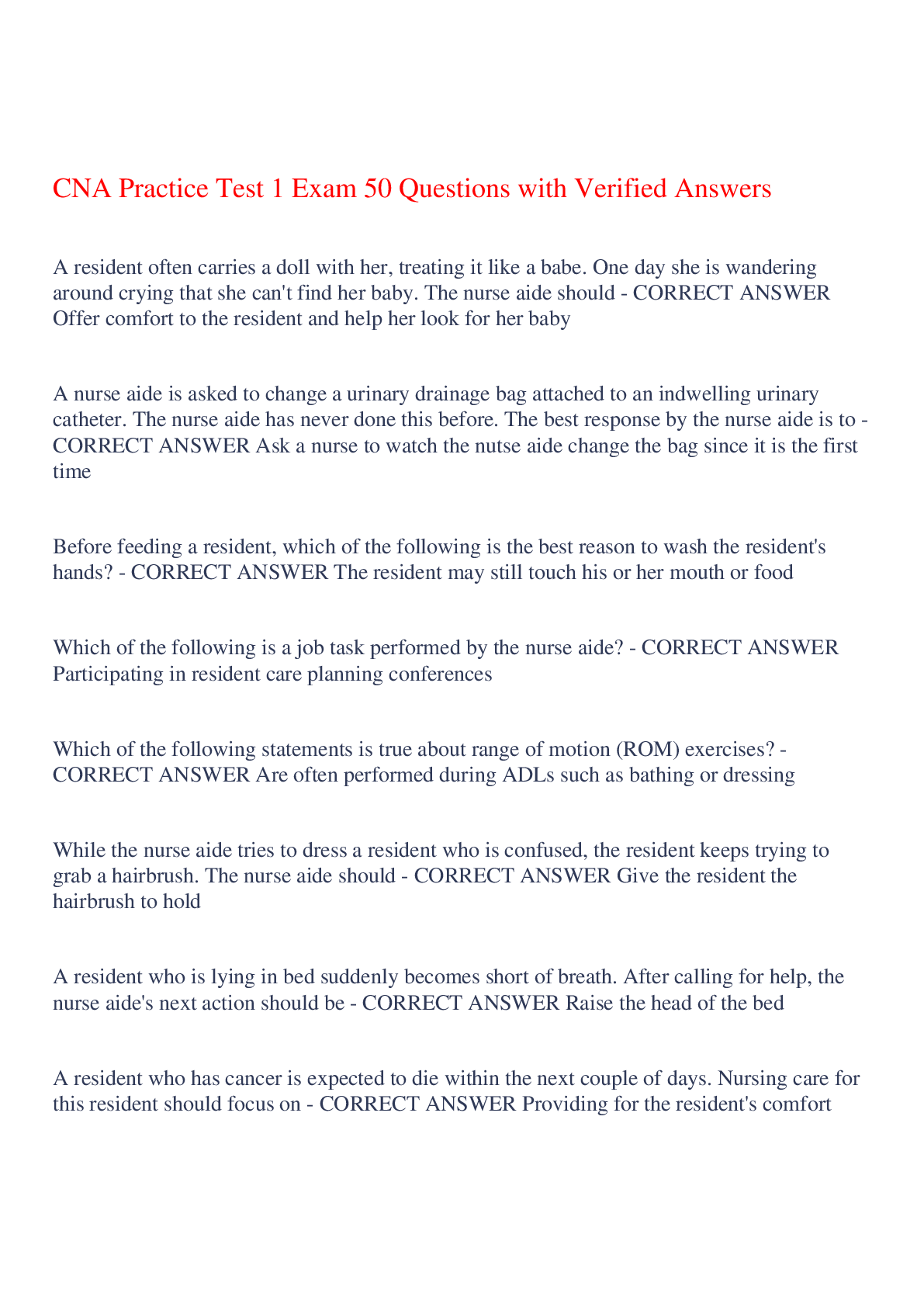Telemetry quiz 66 Questions with Verified Answers,100% CORRECT
Document Content and Description Below
Telemetry quiz 66 Questions with Verified Answers Rule of 1500 - CORRECT ANSWER Calculate rate by counting the number of small boxes between 2 consecutive beats and divide into 1500 8 small boxe... s: rate = - CORRECT ANSWER 188 9 small boxes: rate = - CORRECT ANSWER 167 11 small boxes: rate = - CORRECT ANSWER 136 17 small boxes= rate - CORRECT ANSWER 88 10 small boxes: rate = - CORRECT ANSWER 150 Normal sinus rhythm (NSR) - CORRECT ANSWER Rhythm initiated in sinus node and travels through the conduction system within normal times frames normal sinus rhythm (NSR) - CORRECT ANSWER Sinus bradycardia - CORRECT ANSWER Rate is less than 60. Rhythm is regular. P wave, PR interval, P:QRS ratio, and QRS are normal Sinus bradycardia - CORRECT ANSWER Sinus tachycardia - CORRECT ANSWER Atrial and ventricular rate between 100 - 150. Rhythm is regular. Sinus Tachycardia - CORRECT ANSWER Sinus Arrhythmia - CORRECT ANSWER Irregular heart beat either too slow or too fast Sinus pause - CORRECT ANSWER Sinus node stops working for a period resulting in at least one cardiac cycle missing. Atrial and ventricular rate regular except for a pause. Sinus pause - CORRECT ANSWER Atrial Flutter - CORRECT ANSWER Single irritable focus in atria issues an impulse that is conducted in a rapid, repetitive fashion. Atrial rate is between 250- 350 per minute. Characterized by P wave "saw tooth" pattern. Absence of baseline between P waves. Atrial flutter - CORRECT ANSWER Controlled to uncontrolled atrial fibrillation - CORRECT ANSWER Ventricular response rate > 100 = uncontrolled. < 100 = controlled. Atrial fibrillation - CORRECT ANSWER Atria become so irritable that multiple focus are initiating impulses. Atria no longer beat, but quiver ineffectively. Atria firing at rate > 350. normal sinus rhythm with premature junctional complexes or contractions (PJC's) - CORRECT ANSWER Early ectopic beat that originated within AV junction. Premature- beat occurs before it is expected Normal sinus rhythm with premature junctional complexes or contractions (PJC's) - CORRECT ANSWER Supraventricular Tachycardia (SVT) - CORRECT ANSWER Tachycardia that originates above the ventricles. Rate greater than 150, QRS complex is narrow, ventricular rhythm is regular. May be unable to identify P waves due to rate. Supraventricular Tachycardia (SVT) examples - CORRECT ANSWER Atrial flutter, atrial tachycardia, junctional tachycardia Junctional Escape Beat - CORRECT ANSWER Ectopic impulse from AV junction when the SA node does not fire. Impulse travels through atrial and ventricular pathways at the same time. Escape is when the SA node fails to initiate an impulse, a lower conduction site initiates the inpukse Junctional escape beat - CORRECT ANSWER Junctional escape beat - CORRECT ANSWER Junctional escape rhythm - CORRECT ANSWER Junctional escape rhythm - CORRECT ANSWER 3 or more junctional escape beats in a row. Intrinsic ventricular rate of a junctional escape rhythm is 40-60 beats per minute Accelerated junctional rhythm - CORRECT ANSWER Rate of AV junctional pacemaker exceeds that of the sinus node. Increased automaticity in AV node and decreased automaticity in SA node Accelerated junctional rhythm - CORRECT ANSWER Accelerated junctional rhythm - CORRECT ANSWER Normal sinus with first degree AV block (1st degree AV block) - CORRECT ANSWER Normal sinus rhythm with first degree AV block (1 degree HB) - CORRECT ANSWER Impulse originates on atria but conduction is slowed through AV node. Results in PR interval greater than 0.20 seconds. Rate atrial and ventricular rhythm are generally regular and normal PRI > 0.20 but QRS is normal Second degree AV block, type 1 - CORRECT ANSWER Second degree AV block, type 1 (2 degree HB, type 1) - CORRECT ANSWER Progressive slowing of conduction through AV node until one impulse is blocked at the AV node, the PR interval gets longer and longer until there is a P wave not followed by QRS complex. Rate: atrial rate will exceed ventricular rate. Regular atria and irregular ventricular rhythm. P waves: normal in size and shape, some not followed by QRS. PRI: lengthens with each cycle. QRS: constant and normal Second Degree AV Block Type 2 - CORRECT ANSWER Second degree AV block, type 2 (2 degree HB, type 2) - CORRECT ANSWER AV node allows some but not all of the P waves to be conducted, some P waves are not followed by a QRS complex. Rate: atrial rate will exceed ventricular rate. Unconducted P waves may occur in a regular pattern, such as every other beat, or randomly without pattern. The PR interval: constant. QRS May be > 0.10 but not always. Third degree AV block - CORRECT ANSWER Third degree AV block (3 degree HB) with junctional escape rhythm - CORRECT ANSWER AV node does not allow any impulses to be conducted to the ventricles. The electrical activity of the upper and lower chambers function independently. P waves and QRS complexes seem to be independent from each other Third degree AV block (3 degree HB) with ventricular escape - CORRECT ANSWER Sinus bradycardia with bigeminal premature ventricular complexes or contractions - CORRECT ANSWER Sinus bradycardia with bigeminal premature ventricular complexes or contractions (PVCs) - CORRECT ANSWER Normal heart beat followed by a premature one Accelerated idioventricular rhythm - CORRECT ANSWER Accelerated Idioventricular rhythm - CORRECT ANSWER No P wave. No PR interval. QRS less than or equal to 0.12 seconds. Irritable spot in the ventricle speeds up to override the SA node resulting in ventricular rate of 40-100. Reminder- the intrinsic ventricular rate of a ventricle rhythm is 20-40 beats per minute. Ventricular escape rhythm/idioventricular rhythm - CORRECT ANSWER Ventricular escape rhythm/ idioventricular rhythm - CORRECT ANSWER 3 or more ventricular escape beats in a row. No P wave. No PR interval. QRS > 0.12. The Intrinsic ventricular rate is 20-40 beats per minute., usually regular. If HR < 20 bpm called Agonal. Sometimes referred to as idioventricular rhythm Ventricular tachycardia - CORRECT ANSWER Ventricular tachycardia - CORRECT ANSWER Ventricular 100 bpm. Atria - unable to assess, no P waves. Rhythm regular. Wide QRS > 0.12. The ventricular rate will be 100-250. 3 or more PVCs in a row is a run of VT. The absolute QRS measurement is often difficult to determine. Ventricular fibrillation - CORRECT ANSWER Ventricular fibrillation - CORRECT ANSWER Lethal arrhythmia. Electrical activity is very chaotic. No QRS, depolarization or contraction of the heart. The heart is unable to pump and will just quiver. Asystole - CORRECT ANSWER Lethal rhythm. Flat line. No evidence of P, QRS, or T waves. The patient is pulseless- no cardiac output. No ventricular rhythm or rate Atrial pacemaker - CORRECT ANSWER Atrial pacemaker - CORRECT ANSWER Pacing spike followed by P wave Ventricular pacemaker - CORRECT ANSWER Ventricular pacemaker - CORRECT ANSWER Pacing spike followed by wide QRS complex Atrioventricular/AV sequential pacemaker/dual chamber pacemaker - CORRECT ANSWER Atrioventricular/AV sequential pacemaker/dual chamber pacemaker - CORRECT ANSWER There should be a spike in front of both the P wave and QRS. Dual chamber pacemakers have the ability to pace in both chambers. Ventricular pacemaker with failure to capture - CORRECT ANSWER Ventricular pacemaker with failure to capture or loss of capture - CORRECT ANSWER Capture is indicated by pacing spike on ECG tracing followed by correct chamber response. Caused by displacement of lead, interruption of pacing system, lead fracture, increasing pacing threshold due to fibrosis, electrolyte imbalance, medications, or ischemia Ventricular pacemaker with failure to sense or under sensing - CORRECT ANSWER Patients intrinsic beats must be present. A spike is seen too soon after an intrinsic beat. The pacemaker is not seeing the patient's intrinsic beat, so it fires when it should not. Note failure to sense R-waves and non-capture with the first 2 beats. Ventricular pacemaker with failure to pace or failure to fire - CORRECT ANSWER Interruption in pacing systems, over sensing - pacer sees things inappropriately, electromagnetic interference atrial fibrillation - CORRECT ANSWER Failure to sense/under sensing - CORRECT ANSWER Normal sinus rhythm with premature atrial complex or contraction (PAC) - CORRECT ANSWER PACs occur when the impulse is initiated somewhere in atria. Impulse travels to the AV node and continues down the normal conduction pathway. P waves may look different from sinus P waves. Possible changes on P wave shape: flattened, pointed, or saw tooth Failure to fire - CORRECT ANSWER Premature atrial complexes - CORRECT ANSWER [Show More]
Last updated: 4 months ago
Preview 1 out of 6 pages

Reviews( 0 )
Document information
Connected school, study & course
About the document
Uploaded On
Dec 14, 2023
Number of pages
6
Written in
Additional information
This document has been written for:
Uploaded
Dec 14, 2023
Downloads
0
Views
87












